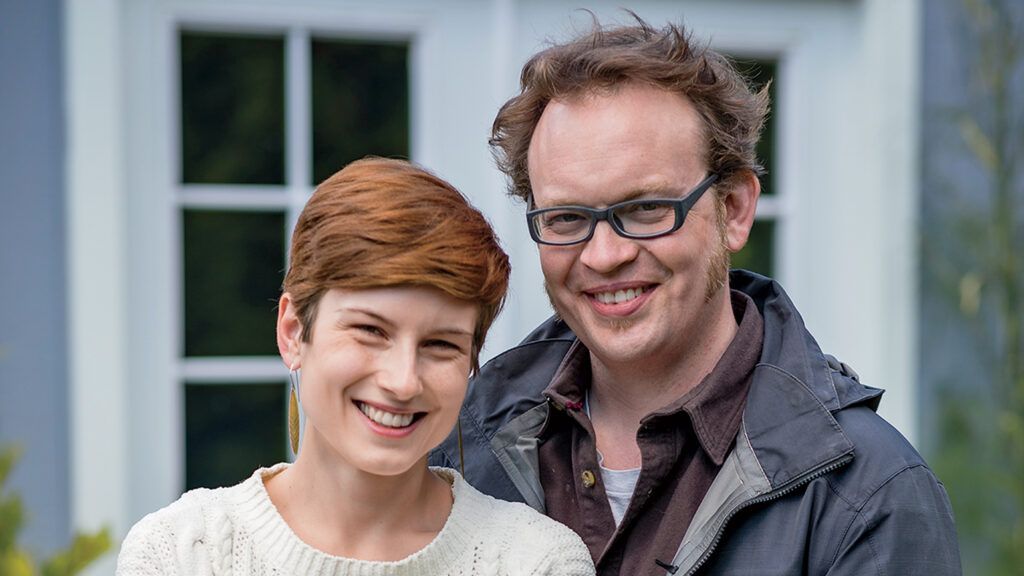If you’re making a turkey this year for Christmas, chances are you’re riffling through Joy of Cooking, the classic American cookbook that families have relied on for generations.
How do I know?
Because I use it too. Me, the great-grandson of Irma Rombauer, the woman who wrote Joy of Cooking in 1931. I ’ve learned to cook from her just like millions of other folks—measuring cup in hand, mixing bowl at the ready. Today my wife, Megan Scott, and I are the latest members of the Joy of Cooking family to work on an update of this beloved collection.
Megan and I have spent years recipe testing, outlining, researching and writing Joy (our shorthand for the book). It’s been a labor of love. Just as it was for Irma’s daughter, Marion, who helped her mom publish the first four editions and carried the next two on her own. Marion’s son (my father) Ethan Becker edited the 1997 and 2006 editions. It may seem like I was a natural to work on the next one, but I had other plans.
My parents divorced when I was a baby. Mom enrolled in nursing school and became an oncology nurse. I spent most of my Thanksgiving and Christmas dinners with her side of the family.
I remember Mom taking Joy of Cooking down from her dining room shelf for the turkey recipe every year. First she’d flip to the pages already marked with gravy drippings and batter stains, then go to the stuffings section for sausage dressing with apples and oyster bread dressing. But all year round, Joy of Cooking helped my working single mom get a good home-cooked meal on the table.
When I was 17 I investigated the book more thoroughly. How was there joy in cooking? I wondered. I had a few omelets and stir-fries under my belt, but caramelized onions was the first recipe I tried that made me feel like a real cook. The onions had to be sliced paper-thin, cooked over low heat for an hour or so, then browned, and finally deglazed. I remember making that initial batch—the waiting, the lazy stirring—and piling the result on a thick slice of bread. When I took a bite I felt a sense of pride and accomplishment.
I took that pride—and my copy of Joy—with me when I started at Boston University to study aerospace engineering. Following the recipes was enough for me.
My dorm at BU was an old converted apartment building. Each room had a tiny kitchen. After class one day I called some friends over for dinner.
I made bone-in chicken breasts in a lemon-herb-garlic marinade; steamed broccoli tossed with lots of butter; and a macaroni dish with minced garlic, Parmesan cheese and heavy cream, topped with extra Parm and a sprinkle of paprika and red pepper flakes. Pretty solid for freshman dorm cooking.
My friends saw the spread, the cookbook lying nearby and the Becker name on its cover. “Wait, is this your family’s cookbook?” one asked.
“Yeah,” I said. “But I never met my great-grandmother Irma or my grandmother Marion. I just follow the recipes like everyone else.”
They gobbled up my feast and divided up the leftovers. Who knew a homemade meal could bring so much happiness?
By the end of freshman year my dream of becoming an aerospace engineer was over. Turned out calculus and I just didn’t mix. I later enrolled at the University of North Carolina to study English literature.
After graduation I worked for a professor, helping him publish books on literary criticism—and as a barista at an Asheville coffeehouse called the Dripolator.
I felt lost. Was this what I’d do with the rest of my life?
One weekend on a visit to my father’s house in Tennessee, a book in his basement caught my eye. Tucked on a shelf was a volume of historical biographies called Contemporary Americans, with a section on my grandmother Marion. In it she talked about keeping Joy a “family affair,” calling it “an enterprise in which the authors owe no obligation to anyone but themselves— and you.”
No one in my family had ever explicitly encouraged me to work on Joy. But my grandmother’s phrasing made me feel as if I was being invited to continue a conversation with readers. What had once seemed like a monumental chore now seemed like an appealing challenge.
The fact that this biography appeared in a library-stacks volume of literary criticism—my field—made me see a connection between the family business and the researching, editing and writing I was doing already. I’d developed the skill set I needed to contribute to Joy just like my grandmother Marion had. It was her meticulously researched revision in 1963 that made Joy of Cooking the staple it is today. For the first time, I felt a real kinship with her, a connection to her book and a wave of relief. All my uncertainties about my life dissolved into a simple desire to devote myself to the task of breathing new life into Joy.
I returned to Asheville invigorated. I started researching each volume of Joy to see how I could update the book for the modern cook.
One day at the coffeehouse a woman with a sassy haircut came in for a latte. I’d seen her lots of times before. She worked down the street at the bakery and always had a book with her. We called her the cheddar-scallion biscuit girl—she liked to bring us some. This time we talked one-on-one and got to know each other. I learned Megan was intent on meeting me—she loved using my family’s cookbook. When we got married I realized it was Joy that had brought us together. And it’s become our life’s work.
The edition we just finished has been updated to reflect today’s kitchen, with more than 600 new recipes. We’ve included gluten-free breads and cakes, as well as instructions for fermenting your own kombucha, charring shishito peppers, curing bacon and making curry pastes from scratch. Of course, we have been faithful to Irma and Marion by keeping the tried-and-true classics that made Joy famous—improved or reworked when necessary, but always with a light hand.
The serving platters on our Thanksgiving table this year will hold turkey, green bean casserole, mashed potatoes, cranberry sauce and one of our favorite recipes we hope you’ll put on your table too: Becker’s Brussels Sprouts, a garlicky side dish browned in a skillet.
Through four generations, from our family to yours, the joy keeps on growing. And that’s something we are always thankful for.
Try John’s recipe for Becker’s Brussels Sprouts at home!
View our photo gallery: The Joy of Cooking Through the Years





